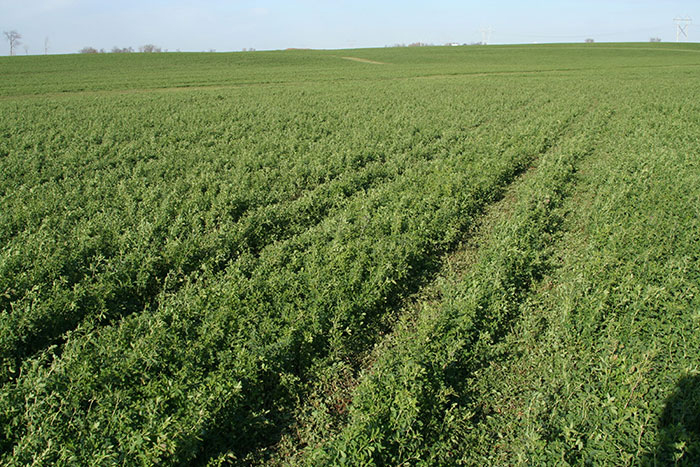
Injecting manure into tilled fields or after an annual crop has been harvested is a common practice. Doing the same into a perennial forage hayfield has been viewed as more problematic because of the potential for mechanical root or crown damage that might affect future production.
Researchers at Cornell University in Ithaca, N.Y., recently reported on a study that evaluated the impact of injecting manure with shallow disks into perennial forage stands of grass and alfalfa. They evaluated both the effects of the manure on forage yields and the impact of the injection disks on subsequent forage production.
Three different types of fields were evaluated: a low-producing tall fescue field (2014 and 2015), a thin, fourth-year alfalfa field (2014 and 2015), and two second-year alfalfa fields (2015). The treatment comparisons were:
- Disk down (no manure)
- Disk down (manure)
- No manure or slicing control
- Surface application of manure (no slicing)
The applications of manure were applied as follows:
| Type | Year | Application rate/timing |
| Tall Fescue | 2014 | 4,000 gal/acre after 1st and 3rd cutting |
| Tall Fescue | 2015 | 8,000 gal/acre after 1st and 3rd cutting |
| 4th-year alfalfa | 2014 | 4,000 gal/acre after 1st cutting |
| 4th-year alfalfa | 2015 | 8,000 gal/acre after 1st cutting |
| 2nd-year alfalfa | 2015 | 4,000 gal/acre in fall 2014 after 4th cutting, then 8,000 gal/acre after 1st cutting |
Here’s what they found
The low-producing tall fescue field responded favorably to the manure applications with 0.39 (combined second and third cuttings, 2014) and 1.49 ton per acre (combined first through fourth cuttings, 2015) higher forage yields.
Manure applications to the older alfalfa stand resulted in 0.40 ton per acre (second through fourth cuttings, 2014) and 0.32 ton per acre (first through fourth cuttings, 2015) additional yield, for both injected and surface-applied manure combined. Though a benefit, the older alfalfa field did not show a manure application response to the degree that the older grass stand did.
The second-year alfalfa stands did not respond to manure additions, and yields in 2015 were more than double that of the older alfalfa stand.
Shallow injection versus surface applying manure did not impact forage yields in any of the three types of fields used for the study. Mechanical damage to plants in this study did not appear to be a yield-limiting factor.
More details on the research trial can be found on Cornell’s What’s Cropping Up? Blog







